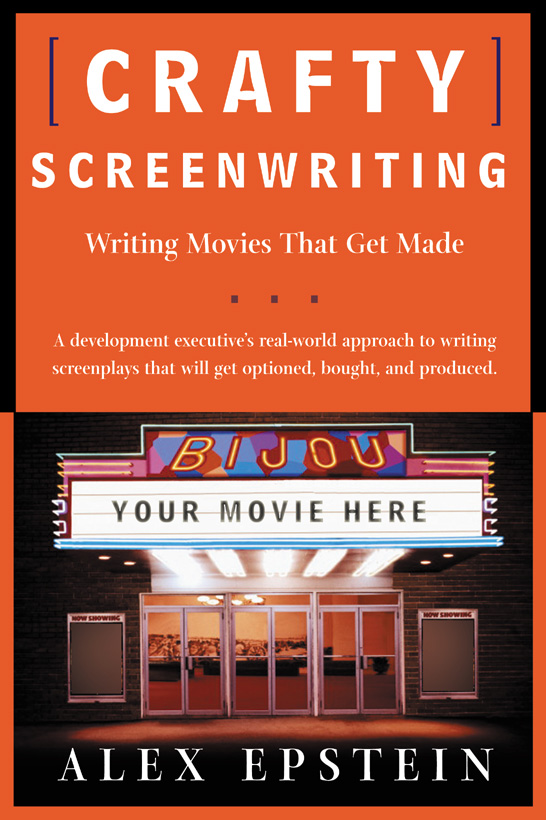
A lot has been written in screenwriting books about three-act structure. The basic idea of drama having three acts goes back to Aristotle. In the beginning, or first act, you get your hero up a tree. In the middle, or second act, he tries to get out of the tree, but ends up even further up the tree. In the finale, or last act, he climbs down or falls out of the tree.
That much is true, but it's not saying much. It's pretty difficult to write a story without a beginning, middle and end.
The terms are useful shorthand, that's all. "First act" is a convenient way to talk about the beginning of the story without someone having to ask, "Do you mean the beginning shot, the beginning scene, the first reel, the first half, what?"
For the purposes of this book,
First Act = the beginning Second Act = the middle Third Act = the end
A certain popular screenwriting author claims confidently that your first act should be 25 to 35 pages long and that your second act should end around page 90. At the end of each act is a "turning point" where the hero's situation drastically changes, his desires change, the flow of the story turns. There is also a "flex point" around page 60 where the situation intensifies.
Horse puckey.
A lot of high-concept off-the-rack thrillers have hard act breaks. The turning points leap up and bite you in the butt. It's moreover true that in the majority of movies, the story is going full steam by no later than the first quarter; things get complicated in the middle half; and everything comes together for a climax in the last quarter.
But only maybe half of all truly great movies have three distinct acts, and in some of those, you have to stretch to figure out where exactly the act breaks are. Where are the act breaks in Hard Day's Night? All that Jazz? How about Spartacus? Forrest Gump? Apollo 13? Annie Hall? Or the superbly written Wild Things, which has about five or six major twists?
Or how about The Wizard of Oz? Does the third act begin when the Wizard sends Dorothy after the Wicked Witch of the East? Or when Dorothy gets home to Kansas? Or when the Wizard turns out to be a fraud? What difference does it make to the story? Who cares where the third act begins?
In The Fugitive, does the second act begin when Dr. Richard Kimble escapes the prison bus, or when he escapes the following manhunt? When does the last act begin? When he discovers the one-armed man? When he confronts Dr. Charles Nichols at the doctor convention? When Marshal Samuel Gerard begins to realize that Dr. Kimble is innocent?
Who cares?
Suppose you could decide where the third act begins. How would that help you understand how the story works?
Many thrillers set up the main character in a short first act, often no more than a precipitating incident. The hero is hounded through a huge second act that keeps picking up the pace. In Alien, there's a well defined first act that gets the alien on board the ship. Likewise, the first act of Predator gets the fireteam into the jungle. But from then on, it all goes downhill from there. A shrinking band of humans is fighting an alien creature. You can say the third act begins when the monster kills off the hero or heroine's last ally, or when the hero or heroine finally starts to turn the tables on his or her enemy, but then you are only finding a second turning point because you are looking for one.
A story can fail in its beginning, its middle or its end, but knowing where you are will not necessarily help you fix the story. I believe that three act structure is overrated. The important thing is to tell a good story and deliver the goods on your hook.
A story can certainly fail structurally. For example, in The Arrival, the hero discovers the truth about the aliens, and enters their big secret headquarters in the jungle, in the middle of the movie. Nothing after that is going to be as interesting, so in essence the movie's over before you get to the "third act." It would have been better if the story was rewritten so that the big discovery happened at the end of the movie, or if there was an even bigger discovery at the end.
But this isn't a question of three act structure. It's a question of giving away too much in the middle and not holding enough back for the end. Worry about whether your story is taking too long to get off the ground, or if you're introducing new characters so fast we don't get to know them well enough. Worry about whether your middle drags, or gets too complicated, or if you are running out of complications and your hero is going to defeat his enemy too quickly and easily. Worry about whether your ending feels rushed, or if you've got more than one scene that feels like an ending.
But don't worry about having three distinct acts. You may find that a five act structure works better for your screenplay. It worked for Shakespeare. You may have a true story that just naturally breaks down into four acts. Squeezing it into the Procrustean bed of Three Act Structure is just going to mangle it.
Just tell a good story that keeps people interested.
Note, however, that if you are turning in an outline to a producer, he will probably want to know where the act breaks are. Pick some plausible page numbers or events and humor him.